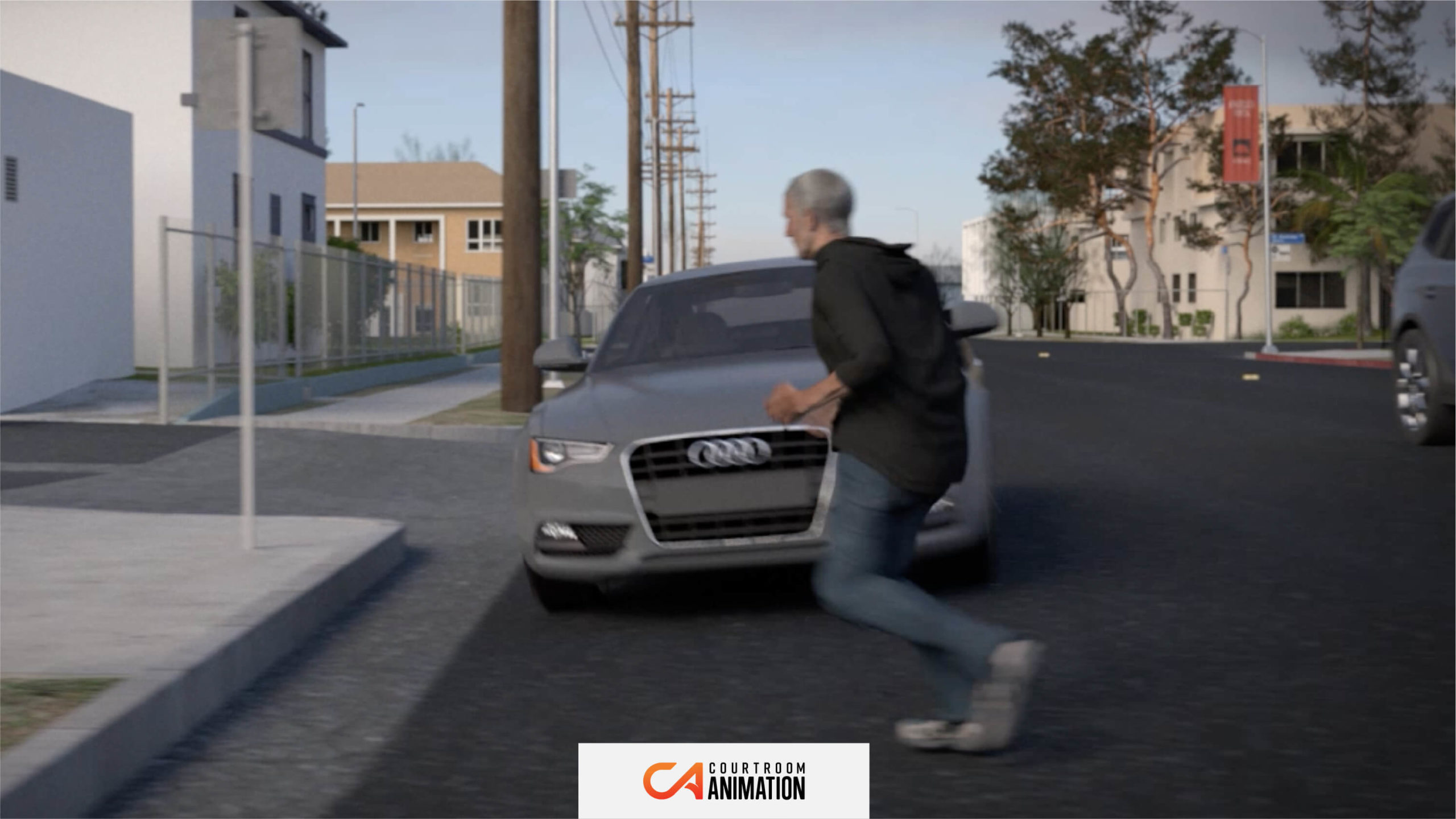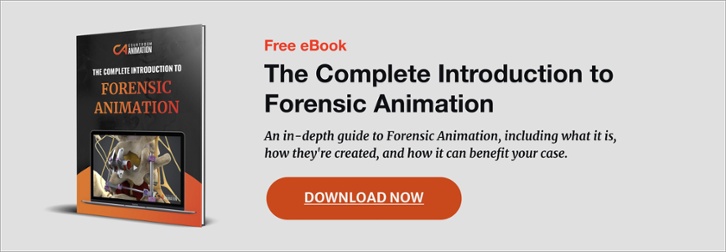
Attorneys have an opportunity to make their trial presentations even more captivating. How? By using legal technology, such as trial animations or legal graphics, to create a stronger narrative around their case.
This concept is not that new for attorneys. Using imagery to convey a case’s narrative was especially important in trials during the height of COVID-19. While remote depositions are common, COVID-19 ushered in a reality of virtual trials and hearings. Having a visual was impactful because remote jurors and judges were less likely to absorb important case facts as they would have in person. Attorneys had to adapt their tactics to create engaging and persuasive presentations over Zoom.
But even with in person trials, your modern juror expects trial exhibits. That’s why using a visual narrative is a huge opportunity for attorneys. In this article, we will discuss how attorneys can go beyond those expectations.
To do so, amplify your case’s narrative by merging data, a storytelling structure, expert visual aids, and powerful closing images. Let’s begin with data storytelling and how it has become a compelling visual strategy for trial attorneys.
Use Data to Enhance Your Narrative
While telling stories to a jury is nothing new, using computer technology to turn complex data into a digestible trial graphics presentation is. Data storytelling is, “the practice of building a narrative around a set of data.” In short, data storytelling helps you to unlock the full persuasive potential of your case.
But how can data be distilled into a demonstrative exhibit? Every memorable story has these core elements:
- Protagonist
- Setting
- Plot
- Antagonist
- Resolution
Each of these variables can be leveraged to amplify your trial graphics presentation. For example, you can depict the protagonist and their adversary (the opposing party), the incident in question, and a setting in one trial animation. Then, you can orally explain the conflict in an easy-to-follow manner for the jury or judge.
Given this theoretical puzzle to solve, the jury will be well-positioned to put the pieces together and fully understand your case’s narrative. When you subtly guide this thought process towards the resolution you prefer using data visualizations, it gives you a better chance that the jury will award a favorable verdict.
If you’re interested in the general pricing of a data visualization for your case, read our free trial animation pricing guide.
Besides turning your complex data into a visual, it can also help keep the jury’s attention on the overall case’s narrative
Simplify & Elevate the Facts With a Hero & Scene
Creating a hero and setting within your trial exhibit is crucial to telling your narrative. You might have a few legal graphics based on data, but emotion must enter the mix. People connect best with people.
Which of the two statements below is more powerful when giving your opening statement to a jury?
- “The defendant collided his vehicle into my client’s vehicle because they were negligent in their duty to brake at the stop sign.”
- “John Smith regrettably lost his life when Harry Jones did not stop for a stop sign and caused a collision.”
Number one may resonate with you as an attorney, since you use language like that in your work, but to a juror, it might come across with professional indifference. Whereas number two gives them a hero – a real person – and an understandable story to empathize with.
It’s all about how you frame it. Complete with a traffic accident animation, the second statement would be a compelling narrative to the jury. (If you want to see a real-world example of this, read this case study that leveraged a car crash animation with various data sets.)
The monetary results of visuals are second to none. In one case, the initial settlement offer was $450K. After presenting the accident reconstruction animation, the defense counsel increased their offer by $550K – for a total of $1M and an over 20x return on investment!
The concept of creating a hero in your case is also applicable in judge-only trials. Some judges might mentally put your case into a box of similar stories they have already heard. That box in their head will impact how the judge feels, and thus rules, about your case. To put your case in the better “box,” frame your case with a hero. And just like the jury, judges have visual biases which trial graphic presentations can appeal to.
Setting the scene and positioning your client as the hero adds credibility and emotional connection to your case, and it also keeps the jury on the edge of their seats.
Add a Visual Spice to Your Expert’s Testimony
In today’s world, the jury will expect imagery of some variety. Think about how the average juror collects and remembers information — through digital animations and images!
Help your audience remember and understand your case’s facts by appealing to more than just their sense of hearing. By giving them a video, an audio explanation, and text to read, your narrative has a higher chance of being remembered.
“Jurors are more media-savvy [than ever before]. Litigators need to raise the bar on their presentation skills.”
David Cheung, Storytelling With High Tech
If your expert’s testimony explains complex data or processes, then a visual can help walk the jury through it through a story. This gives the jury a narrative to absorb and better understand the information.
End Your Closing Statement with a Bang
Every story needs a resolution that keeps the audience thinking about it well into the future. Or, in a jury trial, when they are determining liability.
“Great trial lawyers are, at their core, storytellers.”
Want To Be a Great Trial Lawyer? Embrace Technology
Provide that final satisfying resolution by combining your storytelling skills and a visual to drive home the narrative of your case. Trial animations do this by helping you avoid repetition, which keeps the jury interested as the trial comes to a close.
One survey found that jurors like technology, and enjoy seeing evidence visually displayed, especially in closing arguments. Here are real comments jurors made about trial exhibits and narrative visuals:
- “Eye contact and an attempt to tell a coherent story to the jury was effective.”
- The closing argument “connected all the dots” and the “summary visual was very helpful.”
- “Clear visuals” and “evidence on the screen” were helpful.
Land a Favorable Verdict with Compelling a Trial Graphics Presentation
Images are a powerful tool for attorneys to present the narrative of their case. With computer software, visuals have become even more compelling and are preferred by jurors and judges alike. And, because trial exhibits are created with a foundation of data, there is a 99% likelihood they will be admissible in court.
Remember that in a persuasive and memorable trial graphic presentation, there is a hero, a scene, a plot, the adversary, and a final outcome.
Trial exhibits help create this narrative for your case’s facts, giving the jury a more memorable experience in person or via communication technology. Trial graphics can also convey the demeanor of a witness, which gives your case’s narrative an empathetic hero. In your closing statements, a visual can help land that final statement that stays in every juror’s mind as they deliberate.
Every attorney is a storyteller in their own way, but not every oral presentation is compelling to the jury. That’s why trial graphics that help them follow a narrative are the present and future of legal presentations.
To obtain accurate and admissible visuals, consider collaborating with an experienced forensic animation company. Or, if you’re interested in learning more about how a trial graphics presentation can support your case, reach out and get a quote from our legal animators today!
